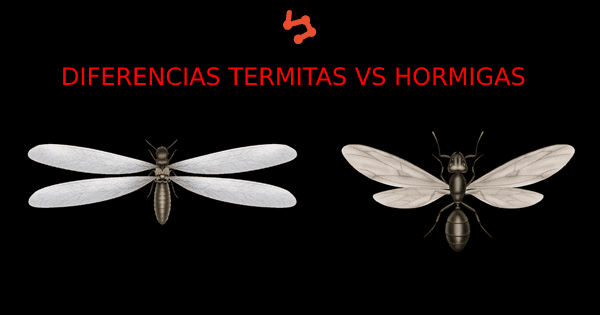Both in spring and autumn, we have the nuptial flights of termites, which can coincide with winged ants, but how can I identify if it is a termite or an ant?
On many occasions we can find in our homes a multitude of specimens that come out of a small hole/crack, how do we know if this insect is a termite or ant? Don’t worry, we explain it to you in detail.
Let’s start with this image:

How do we identify them?
Termites have only head and thorax, while ants have head, abdomen and thorax, that is, the body of the termite is composed of 2 bodies while the body of the ant is composed of 3 bodies.
The antennae, if we look closely, we can see that the antennae of termites are formed with small balls, while the antennae of ants are completely straight ending with L.
Wings, we can see that termites have 2 sets of wings completely the same, moreover, the wings are always larger than their body, while ants have 2 sets of wings, one larger than the other, and on many occasions the wings are smaller than their body.
The only food of termites is cellulose, many times when a client calls us and we go to carry out the inspection, we can observe how the frame of their room is completely eaten, leaving only the thin layer of paint on the door. The ants’ food base is protein and sugars.
They are not visible, The habitat of a termite depends on the species. Unless you spot a swarm, you’re more likely to spot signs of termites rather than winged termites. The most likely signs that indicate that we have themes would be; Visualize discarded wings, mud trails or tubes, and damage to wood from subterranean termites. Termite granules, or “droppings,” can be a sign of drywood termite. Ants, on the other hand, will venture out to forage for food, so you might see them in your home.
Attractants, the moisture in your home attracts both ants and termites. Normally, they are also attracted to wood and easy entry points. However, that’s where the list of what attracts ants and termites starts to veer.
Another difference between termites and ants is that ants don’t eat wood (as mentioned above), so they’ll be attracted to other food sources and can be seen wandering around windows and baseboards.
Can we confuse winged ants with winged termites?
Yes, termites can be mistaken for ants (and vice versa), especially when flying during a swarm. We’ve described some key differences in their appearance above, such as body shape, antennae, and wings. But it can certainly be difficult to spot these differences. This is where a trained xylophage control professional can help.
On many occasions we have been asked if they are termites and white ants , the same, and indeed on many occasions we could confuse a termite with an ant, they are very similar in appearance but the color distinguishes them completely.
If you think you have any of the pests in your home, contact Termicor. A trained pest control professional can assess your problem and work with you to customize a control and prevention plan.


